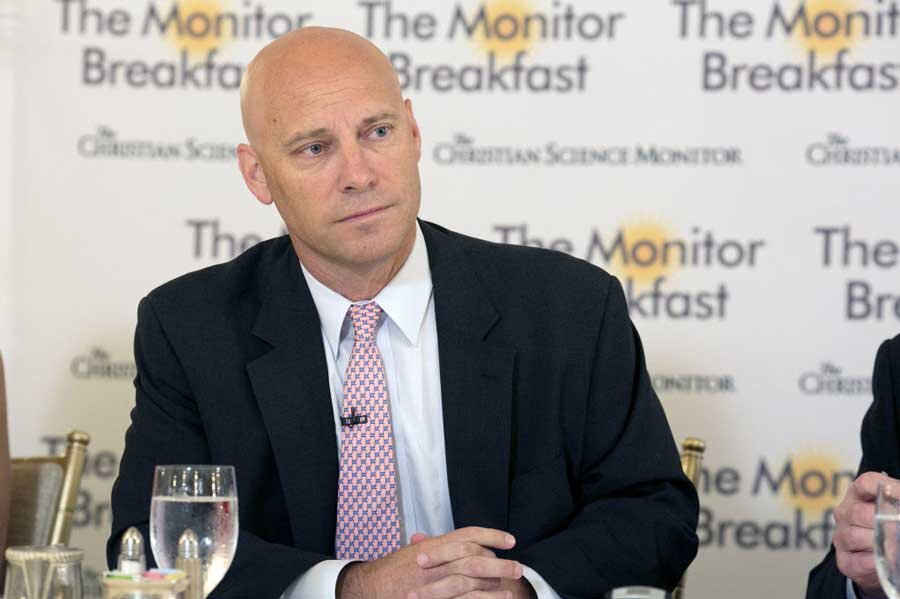On tax reform, Trump looks to avoid the same fate as health care
Loading...
| Washington
As President Trump and Republicans on the Hill move toward their next big goal – overhauling the tax code by the end of the year – the White House is taking a different approach than it did with health care reform, which went down to an embarrassing defeat this summer for lack of Republican votes.
Instead of allowing GOP leaders to determine the details of the legislation, the president is aggressively pushing for his stipulation that the corporate tax rate come down to 15 percent. He believes that will increase US competitiveness globally, and create jobs.
Republicans on the Hill have said this is unaffordable, with House Speaker Paul Ryan (R) of Wisconsin saying that meeting or beating the average corporate rate of 22.5 percent for industrialized countries is more realistic.
But the president’s legislative director, Marc Short, said at a Monitor breakfast with reporters on Tuesday that 15 percent is “best” and will create the most jobs. Getting this rate as a part of a legislative overhaul is more important than another point of disagreement with congressional Republicans – corporate expensing methods.
“It doesn’t help ourselves to negotiate against ourselves,” said Mr. Short, who has considerable experience on the Hill as a former senior Republican aide. He said that while ultimately "there's probably compromise" necessary to get a deal, "we think that what's best for the American people is a 15 percent corporate rate right now."
Another key difference from the health care process: The White House has been consulting with various conservative groups in advance of any legislative plan. Over the summer, said Short, the White House was engaging with outside groups such as the Club for Growth to avoid the kind of blowback from conservatives that hit GOP “repeal and replace” efforts early on.
“That is a lesson learned,” he said.
Still, this outreach has not stopped criticism among Hill conservatives, who complain that they have yet to see a detailed tax plan emerge from negotiations between key GOP leaders on the Hill and the White House.
Short said that a plan would be released in days, not weeks, and that members would have a chance to see it before they vote on a budget resolution – a necessary legislative precursor to tax reform.
Republicans plan to use a budgetary process that would allow them to pass tax reform with a majority-only vote in both chambers.
That’s the same process they used to try to pass a health-care plan without any Democratic votes. It is far from clear that they will do any better with tax reform, given that heavy lifts like this usually need bipartisan votes to pass.
Short, acknowledging that Republican support in the Senate for repealing and replacing the Affordable Care Act was “not reliable,” said the president wants bipartisan backing for a tax package, and that’s why the White House has been meeting with some Democrats as well as Republicans. "We don't feel like we can assume that we can get tax reform done strictly on a partisan basis," he said.
Despite the president’s emphasis on a middle-class tax cut, however, Democrats object to tax cuts for the wealthiest Americans and other aspects of the president’s broad framework.
On another big issue – immigration – Short said the White House will be laying out a set of priorities relating to the so-called “Dreamers” within a couple of weeks.
Last week, the president announced he was unwinding President Obama’s “Deferred Action for Childhood Arrivals” program, known as DACA. The program applies to young undocumented adults brought into the country as children and allows them to live and work in the United States without fear of deportation.
On the Hill, it’s assumed that the two parties will have to strike a deal that gives Republicans enhanced border security and Democrats a law that codifies DACA, which was done through executive action. But Short did not insist on such a deal, saying the White House doesn’t want to “bind” itself into any particular legislative construct.
Still, he laid out the elements of immigration reform that are important to the president: border enforcement – including a physical barrier, interior enforcement, and a merit-based immigration system.








